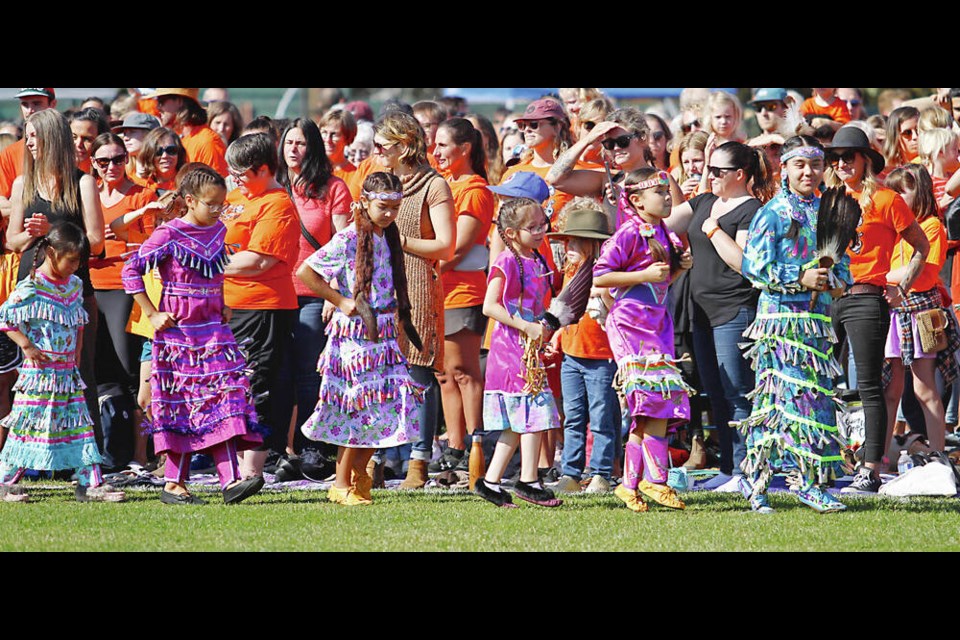From the entry area to the Royal Athletic Park stadium on Friday, Songhees Nation Coun. Margaret Charlie looked down at the field, where regalia-adorned dancers, young and old, performed the Survivors Honour Dance for a giant powwow circle of people wearing orange.
What’s important about today, Charlie said, is that through it all, Indigenous people are still here, and so are their cultures.
The dance was one of many during the first ever Coming to Gather Again South Island Powwow, an event hosted by Songhees First Nation and the City of Victoria, marking the second National Day of Truth and Reconciliation.
Thousands gathered at the stadium Friday to take in the powwow, which featured dancers from across the Island and Lower Mainland, including Tsawout First Nation, Kwakwaka’wakw, Nuu-Chah-Nulth and the Métis Nation. Dancers moved to the singing and drumming of Star Child, a group of singers and drummers from Haida/Six Nations, Creek Dakota, Blackfoot, Lil,wat, Squamish, Mamalilikulla and Kwakwaka’wakw.
“We knew from our social media page that was created [for the event] that there was a lot of interest,” Charlie said.
“It’s an overwhelming response. We’re extremely grateful for everyone that’s come and walked through the doors.”
The event, which ran 14 hours from 10 a.m. to midnight, was meant to share culture and recognize survivors of residential schools and the Sixties Scoop. The day started with opening prayer and dance and a moment of silence.
From the bleacher seats, Stephanie Pelkey of Tsawout First Nation watched the powwow with her family. She is a survivor of Kuper Island Residential School.
“It’s an emotional day. I witnessed so much as a little girl and I remember a lot of it,” she said. “I myself, try not to use it as a reason to get lost. I use it as my own little tool to keep moving forward.
“It’s an overwhelming experience to see so many young kids supporting this,” she added. “They ask a lot of questions. I think that’s how more and more people are becoming aware of what happened.”
The powwow kicked off just as a Victoria Orange Shirt Day event came to a close at Centennial Square, where a smaller but equally orange-clad crowd piled into the plaza to hear from residential school survivors and community leaders, along with dancing and song.
Orange was the colour of the day because of what happened to Phyllis Webstad. When she was at St. Joseph Mission Residential School in the 1970s, she had an orange shirt, a gift from her grandmother. School officials took it from her as part of a policy to strip away Indigenous identity.
Webstad’s story led to the organizing of Orange Shirt Day, which became the National Day of Truth and Reconciliation.
Eddy Charlie, of Cowichan Nation, a co-founder of the event at Centennial Square, spoke about his experience at Kuper Island Residential School, recalling how the children had their hair cut and clothes taken away, the beginning of a process to strip their identities as Indigenous people.
“I was a tiny child when they came and took me away from my parents and grandparents,” he said. “People were beaten in residential schools for speaking the language that was sacred to their heart and their spirit.”
Charlie said the stories are hard to hear and hurt to tell, but must be shared.
“The more you tell the story of your pain and your trauma, the easier it becomes for you to allow yourself to heal,” he said.
When the Orange Shirt Day event ended, Mayor Lisa Helps rushed from the square to the stadium for the powwow’s grand entry, and was overwhelmed by the amount of people already at Royal Athletic Park.
“I was floored,” she said. “There were thousands of people and a sea of orange.
“What’s really amazing is that after everything the colonial state has done, the culture lives on,” Helps said. “This powwow is a testimony to the resilience of Indigenous people.”
ngrossman@timescolonist.com
>>> To comment on this article, write a letter to the editor: letters@timescolonist.com


